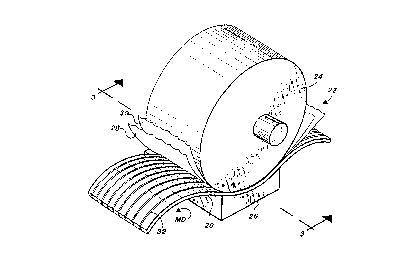Some of the information on this Web page has been provided by external sources. The Government of Canada is not responsible for the accuracy, reliability or currency of the information supplied by external sources. Users wishing to rely upon this information should consult directly with the source of the information. Content provided by external sources is not subject to official languages, privacy and accessibility requirements.
Any discrepancies in the text and image of the Claims and Abstract are due to differing posting times. Text of the Claims and Abstract are posted:
| (12) Patent Application: | (11) CA 2212284 |
|---|---|
| (54) English Title: | ANISOTROPIC REINFORCED RIBBON-CAST BLANKET FOR EXTENDED NIP PRESS |
| (54) French Title: | TOILE RAINUREE A RENFORT ANISOTROPIQUE POUR PRESSE A PINCE ALLONGEE |
| Status: | Deemed Abandoned and Beyond the Period of Reinstatement - Pending Response to Notice of Disregarded Communication |
| (51) International Patent Classification (IPC): |
|
|---|---|
| (72) Inventors : |
|
| (73) Owners : |
|
| (71) Applicants : |
|
| (74) Agent: | SMART & BIGGAR LP |
| (74) Associate agent: | |
| (45) Issued: | |
| (22) Filed Date: | 1997-08-05 |
| (41) Open to Public Inspection: | 1998-02-13 |
| Examination requested: | 1997-08-05 |
| Availability of licence: | N/A |
| Dedicated to the Public: | N/A |
| (25) Language of filing: | English |
| Patent Cooperation Treaty (PCT): | No |
|---|
| (30) Application Priority Data: | ||||||
|---|---|---|---|---|---|---|
|
A conventional blanket material, preferably a woven fabric or
scrim, is formed into a loop of the desired dimensions and impregnated
and coated with a two-component urethane resin. As the urethane is
applied to the woven substrate, short fibers are introduced into the
urethane through a nozzle which aligns the fibers to run in the
cross-machine direction. The fibers are introduced in sufficient
quantities to provide significant structural reinforcement of the urethane
in the cross-machine direction. The coated blanket is then ground to a
desired constant thickness and an array of parallel grooves running in
the machine direction are milled into the urethane coating. The
anisotropic fiber reinforcement provides sufficient modulus to the
urethane system to prevent the grooves from collapsing under the
applied loads of the extended nip press. The reinforcing fibers may be
glass, carbon fiber, synthetic polymer or other structural fiber material.
Cette invention concerne une toile classique, de préférence un tissu ou un canevas, en boucle sans fin de dimensions voulues et imprégnée et enduite d'une résine uréthanne deux composants. Durant l'application de l'uréthanne sur la toile, des fibres courtes sont injectées dans l'uréthanne au moyen d'une buse qui aligne les fibres en sens travers de la machine. Les fibres sont ajoutées en quantités suffisantes pour renforcer appréciablement l'uréthanne en sens travers de la machine. La toile ainsi revêtue est alors dressée à l'épaisseur voulue, puis le revêtement est soumis à un traitement de rainurage parallèle dans le sens machine. Le renfort de fibres anisotropique confère au revêtement d'uréthanne une résistance suffisante pour s'opposer à l'écrasement des rainures sous les charges subies au passage dans la pince de la presse. Les fibres de renfort peuvent être des fibres de verre, des fibres de carbone, des fibres polymères de synthèse ou des fibres de toute autre matière appropriée.
Note: Claims are shown in the official language in which they were submitted.
Note: Descriptions are shown in the official language in which they were submitted.

2024-08-01:As part of the Next Generation Patents (NGP) transition, the Canadian Patents Database (CPD) now contains a more detailed Event History, which replicates the Event Log of our new back-office solution.
Please note that "Inactive:" events refers to events no longer in use in our new back-office solution.
For a clearer understanding of the status of the application/patent presented on this page, the site Disclaimer , as well as the definitions for Patent , Event History , Maintenance Fee and Payment History should be consulted.
| Description | Date |
|---|---|
| Inactive: IPC assigned | 2022-08-11 |
| Application Not Reinstated by Deadline | 2000-08-07 |
| Time Limit for Reversal Expired | 2000-08-07 |
| Inactive: Abandoned - No reply to s.30(2) Rules requisition | 1999-09-13 |
| Deemed Abandoned - Failure to Respond to Maintenance Fee Notice | 1999-08-05 |
| Inactive: S.30(2) Rules - Examiner requisition | 1999-03-11 |
| Inactive: IPC assigned | 1998-04-03 |
| Inactive: IPC assigned | 1998-04-01 |
| Inactive: IPC assigned | 1998-04-01 |
| Inactive: IPC assigned | 1998-03-31 |
| Inactive: First IPC assigned | 1998-03-31 |
| Inactive: IPC removed | 1998-03-31 |
| Inactive: Single transfer | 1998-03-20 |
| Application Published (Open to Public Inspection) | 1998-02-13 |
| Inactive: First IPC assigned | 1997-10-27 |
| Inactive: IPC assigned | 1997-10-27 |
| Classification Modified | 1997-10-27 |
| Inactive: Courtesy letter - Evidence | 1997-10-21 |
| Filing Requirements Determined Compliant | 1997-10-14 |
| Inactive: Filing certificate - RFE (English) | 1997-10-14 |
| Application Received - Regular National | 1997-10-10 |
| Request for Examination Requirements Determined Compliant | 1997-08-05 |
| All Requirements for Examination Determined Compliant | 1997-08-05 |
| Abandonment Date | Reason | Reinstatement Date |
|---|---|---|
| 1999-08-05 |
| Fee Type | Anniversary Year | Due Date | Paid Date |
|---|---|---|---|
| Registration of a document | 1997-08-05 | ||
| Application fee - standard | 1997-08-05 | ||
| Request for examination - standard | 1997-08-05 |
Note: Records showing the ownership history in alphabetical order.
| Current Owners on Record |
|---|
| BELOIT TECHNOLOGIES, INC. |
| Past Owners on Record |
|---|
| EUGENE L. SLAGOWSKI |
| PAUL MCCARTEN |